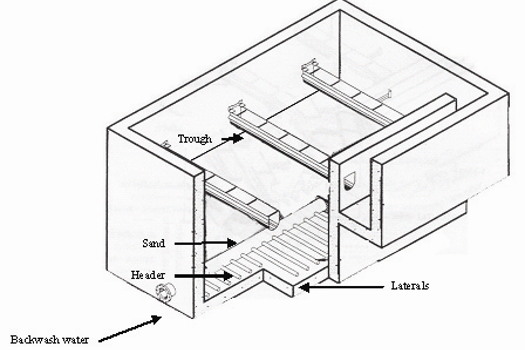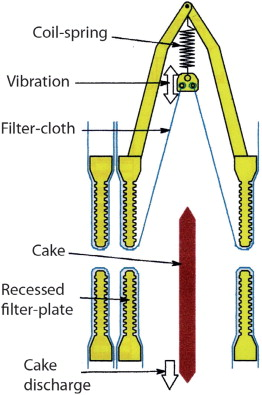
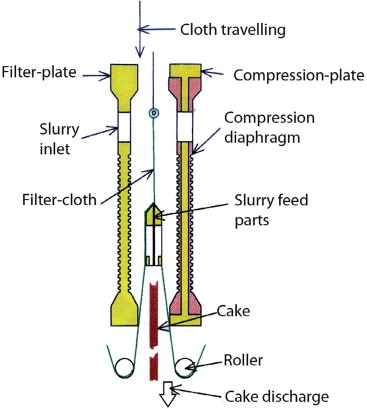
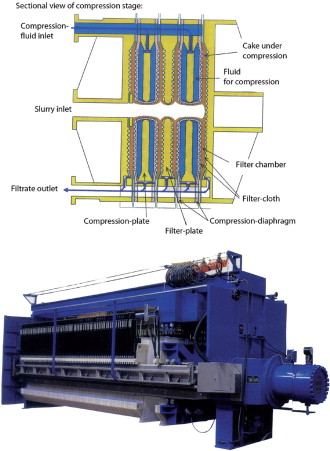
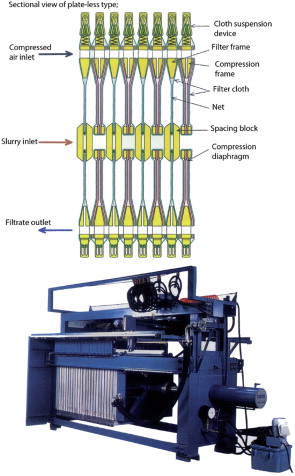
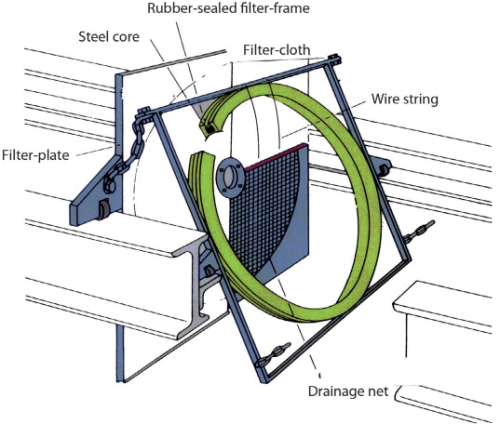
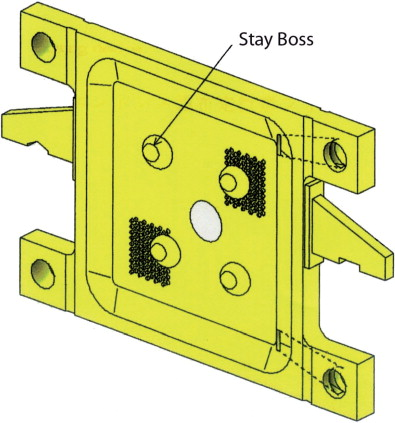
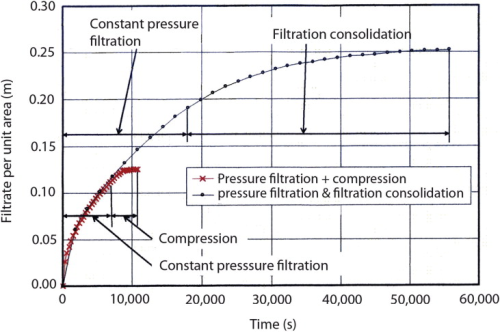
History recounts that the first form of a filter press was contained in British patent of 1853 for obtaining seed oil through the use of numerous pressure cells. The main advantages of the filter press are high filtration velocities and low moisture content in formed filter cakes, due to the high filtration pressures that can be applied. Consequently, filter presses have long been used for a wider range of applications than any other type of filter. However, disadvantages of the filter press include intermittent operation and high labour requirements. Therefore filter presses might be regarded as inferior to continuous, vacuum filters. In the middle of the 20th century, the requirements of mass production in industry had arrived. As a result increasing attention was paid to the automation of filter press operations, and the fully automatic horizontal-type and various other new types of filter press were developed in Japan.
Automatic horizontal-type recessed-plate filter press
To meet this growing industrial demand, in 1953 K. Kurita and S. Suwa began working on the development of an automatic filter press at Kurita Machinery Mfg. Co. in Osaka, a major filter press manufacturer since 1930. First they developed automatic cake discharge methods from a recessed-plate-type filter press. After several failures, they developed the world's first fully automatic horizontal-type filter press in 1959, which was introduced to industry the following year.
The mechanism of automatic cake discharge is that the recessed-filter plates are moved, one by one, to allow a regular interval of 60% of the filter plate dimension (see Figure 1). Through the use of suitable fixing devices, the filter cloth between two recessed-plates becomes V-shaped, as shown. The cake that has formed on the cloth drops under its own weight. For sticky cakes, the top of the inverse V-shaped suspension, shown in the figure, is tapped mechanically for a few seconds at about two cycles per second to ensure cake removal from the filter cloth. However, the real developments in this area have been led by improvements in synthetic filter media, providing excellent cake removal, blinding resistance, and reduced moisture absorption, as well as automatic electronic control features.
In order to reduce the time taken for cake discharge in automatic filtration operations, the separate filter-cloth travel-type fully automatic horizontal filter press was developed in 1972. The method essentially consists of firstly moving all filter plates simultaneously to have the same plate space of around 50–70mm, and secondly reversing the direction of all downwards-travelling filter cloths to upwards via the rollers, as shown in Figure 2. Although the separate filter-cloth travel type reduces cake discharge time, even for thin, sticky cakes, disadvantages include that the mechanisms are rather complicated, the apparatus becomes longer, and the procedures for exchanging the filter cloth are complicated.
Automatic horizontal-type recessed-plate filter press with diaphragm compression
Deliquoring filter cakes is a basic requirement for cake drying and maximum yield of filtrate. For sewage sludge treatment, it is important in energy saving for incineration, transportation, composting and land-fill, for example. In 1968 Kurita Co. began working to decrease moisture content in filter cakes by using flexible diaphragms, actuated hydraulically or pneumatically, as shown in Figure 3. By 1971 the fully automatic filter press with diaphragm compression had been introduced. By actuating the diaphragm, the optimum operating condition can be easily achieved for a given, fixed filter-chamber thickness. The device is good for optimising automatic filtration cycles, cake compression (cake washing and gas-blown deliquoring, if necessary), cake discharge, and filter-cloth washing. This increased the suitable areas of application, including sewage sludge treatments.
Automatic filter-frame-type filter press (Plate-less-type filter press)
The addition of compression diaphragms for a filter press resulted in the development of a new type of filter press, the plate-less type filter press, which is composed only of filter frames (see Figure 4). The role of the recessed filter plate is that of a filter chamber partition which is subjected to approximately equal but opposite pressures on both surfaces of the recessed-plate, as well as providing filter cloth support and filtrate flow channels. As illustrated in Figure 4, the automatic plate-less type filter press comprises a series of filter frames equipped with compression diaphragms and filter cloths, as well as drainage net. For slurry inlets to the filter chambers, there are spacing blocks provided.
The advantages of the plate-less type are short machine length and the apparatus is lightweight. The main disadvantage is that both filtration and compression pressures are limited, and are rather low at around 0.4MPa for filtration and 0.7MPa for compression.
Materials
The materials for filter plates and filter frames, compression diaphragms and filter media for automatic horizontal-type filter presses must be considered.
Filter plates and frames for conventional filter presses are available in a wide range of materials, including various metals, coated metals, plastics and wood. Eighty to ninety percent of all filter plates and frames for automatic filter presses produced in Japan are made of polypropylene, often reinforced by talc or glass fibres. Polypropylene can be used successfully at 5–80°C. It generally has good resistance to acids and alkalis, low specific gravity (0.90), low price, and is easy to machine.
Automatic filter presses are now made in the maximum plate size of 2m × 2m, with a maximum number of chambers of 170, which gives a maximum filtration area of 1,190m2. Operating filtration pressures are usually 0.4–1.4 MPa using centrifugal pumps or a maximum of 4–6 MPa using diaphragm or plunger pumps.
The materials used for compression diaphragms are natural or synthetic rubbers (for example, EPDM, EPT, NBR or CR), and various synthetic resin elastomers. Although natural rubber is most widely used, it cannot be used for slurries containing oily materials. It will not perform adequately above 60°C. For food and beverage processing, odourless diaphragm materials have to be used. Diaphragm durability can be enhanced by the insertion of cloth cords into the rubber diaphragms. Compression pressures are usually 0.6–2.6MPa.
There are a number of features of the filter media used for automatic filter presses that are important. They are gasket quality, good cake release and blinding resistance, dimensional stability, reduced moisture absorption, and resistance to wear, abrasion, and chemicals. Polypropylene and polyester fabrics are now most widely used, usually in their woven forms.
Automatic horizontal-type filter press: plate-and-frame-type
Automatic cake discharge from a plate-and-frame-type filter press (flush-plate-type) is more difficult than cake release from a recessed-type. Ito Mfg. Co., based in Seto-city, Japan, developed the automatic plate-and-frame type filter press (see Figure 5), where the filter plates are simply composed of steel plates covered with filter cloths, and the filter frames are made of square-shaped, steel ring cores, covered by thick rubber seals. The inside surfaces of the rubber seals are concave-shaped. Automatic cake release from each filter frame is undertaken by tilting a frame. The filter press is simple in construction and is used successfully for filtration of wastewater containing rather low resistance solids exhausted from ballast and pebble crushing, and clay mining plants.
Future developments
There are a number of developments in various industries regarding the future of automatic horizontal-type filter presses. During a filtration process with a conventional horizontal-type filter press, the chambers of the filter press cannot always be the same in terms of the degree of cake formation, due to various, possible inequalities. The imbalances among filter cakes formed in the filter chambers cause appreciable recessed-plate deformation, and sometimes lead to plate brakeage. The recessed-plates for conventional filter presses are provided with bosses (see Figure 6), which have been believed to only give extra support during press closing and are not essential. The author believes that the stay bosses are the result of accumulated experiences by developers for avoiding plate destruction. For filter presses with compression devices, plate destruction never occurs and the bosses are not needed.
Fully automatic horizontal-type filter presses equipped with diaphragm compression devices have increased their fields of application and now include sewage sludge treatment. Figure 7 shows field test results on filtering thickened sludge of 0.54% solids from deep-well water works using two kinds of filters — a conventional recessed-plate filter press with a chamber thickness of 8.5mm, and a fully automatic filter press with diaphragm compression and a chamber thickness of 30mm. The thickness of 8.5mm for the conventional type was selected on the basis of one batch operation per day. Pressures for filtration and compression are both 0.69MPa to yield 75% moisture cakes.
The moisture decrease in formed cakes for the non-compression type proceeds very slowly through filtration-consolidation phenomena due to the slow changes in liquid flow patterns in cakes, after the chambers are filled with normal filter cakes. However, dewatering by diaphragm compression proceeds quite rapidly as shown in the figure, and optimum operating conditions can be easily established on the basis of filtration-and-consolidation characteristics and the downtime.
The filter press with the compression device treats half the amount of sludge in less than a quarter of the time, in other words the capacity is more than twice that of the conventional filter press. Separated liquid is recycled to the plant, and the dewatered sludge is used on farmland or goes to landfill. For extremely high degrees of dewatering, mainly for waterworks sludge, an automatic filter press with diaphragm compression and also with an electro-osmotic dehydrator device of carbon electrodes was also developed in Japan. However, the field of application may be limited to sludge with only low electrical conductivity.
In order to meet the increasing demands for higher degrees of deliquoring from difficult-to-filter materials, attempts are being made to develop super-high pressure filters. Recently, Kurita developed a high pressure automatic horizontal-type filter press for oleic fatty acid separation from palm oil. The filtration pressure is 0.3MPa, and the compression pressure is as high as 5.0MPa. The recessed-filter-plates are 1,500mm × 1,500mm, with 176 chambers. For discharging cakes, 22 plates are opened at one time to have the same 50mm clearances between plates. The filter plates and diaphragms are made in Germany. In view of the fact that the pressures during filtration and compression differ greatly, the hydraulic ram pressures actuated for tightening the filter plates are regulated to be linearly proportional to the operating pressures during filtration and compression, to decrease excess loads on the filter. The filters are now working successfully. The trend towards increasing the pressure of automatic filter presses may continue into the future, and international collaboration for solving these worldwide difficulties will be increasingly important.
In the modern filtration industry, market demands are becoming increasingly elaborate and require finer and higher degrees of separation, particularly for the purposes of material recycling, energy cost saving, and essential environmental protection. Recent developments in various filters and separation equipment, including automatic filter presses, will continue to provide the technological tools for solving these important problems.




